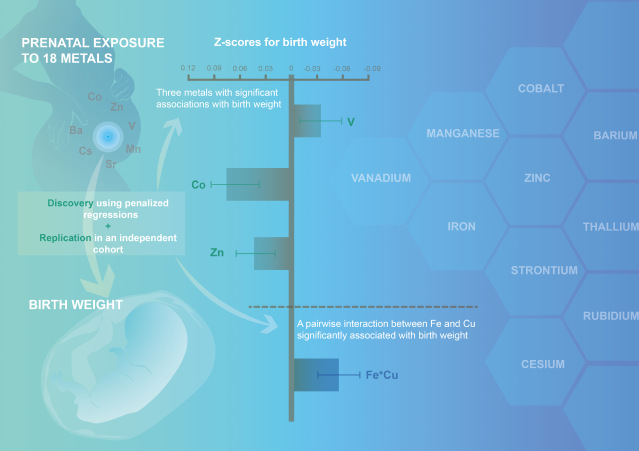
Highlights
Prenatal exposure to metal mixtures impacts newborns’ birth weight.
As components of a mixture exposure during pregnancy, both individual metals (vanadium, cobalt, and zinc) and their pairwise interactions (iron×copper) could impact birth weight.
The approaches used in this study could be applied to examine the health effects of complex mixtures of heavy metals and trace elements, endocrine-disrupting chemicals, and nutritional factors.
Abstract: The understanding of the impact of prenatal exposure to metal mixtures on birth weight is limited. We aimed to identify metal mixture components associated with birth weight and to determine additional pairwise interactions between metals showing such associations. Concentrations of 18 metals were measured using inductively coupled plasma mass spectrometry in urine samples collected in the 3rd trimester from a prenatal cohort (discovery; n = 1,849) and the Healthy Baby Cohort (replication; n = 7,255) in Wuhan, China. In the discovery set, we used two penalized regression models, i.e., elastic net regression for main effects and a lasso for hierarchical interactions, to identify important mixture components associated with birth weight, which were then replicated. We observed that 8 of the 18 measured metals were retained by elastic net regression, with five metals (vanadium, manganese, iron, cesium, and barium) showing negative associations with Z-scores for birth weight and three metals (cobalt, zinc, and strontium) showing positive associations. In replication set, associations remained significant for vanadium (β = -0.035; 95% confidence interval [CI], -0.059 to -0.010), cobalt (β = 0.073; 95% CI, 0.049 to 0.097), and zinc (β = 0.040; 95% CI, 0.016 to 0.065) after Bonferroni correction. We additionally identified and replicated a single pairwise interaction between iron and copper exposure on birth weight (P < 0.001). Using a two-stage analysis, we identified and replicated individual metals and additional pairwise interactions-associated birth weight. The approach could be used in other studies estimating the effect of complex mixtures on human health.
Keywords: Prenatal exposure; Metal mixture; Birth cohort; Two-stage analysis
DOI: 10.1016/j.eehl.2022.09.001